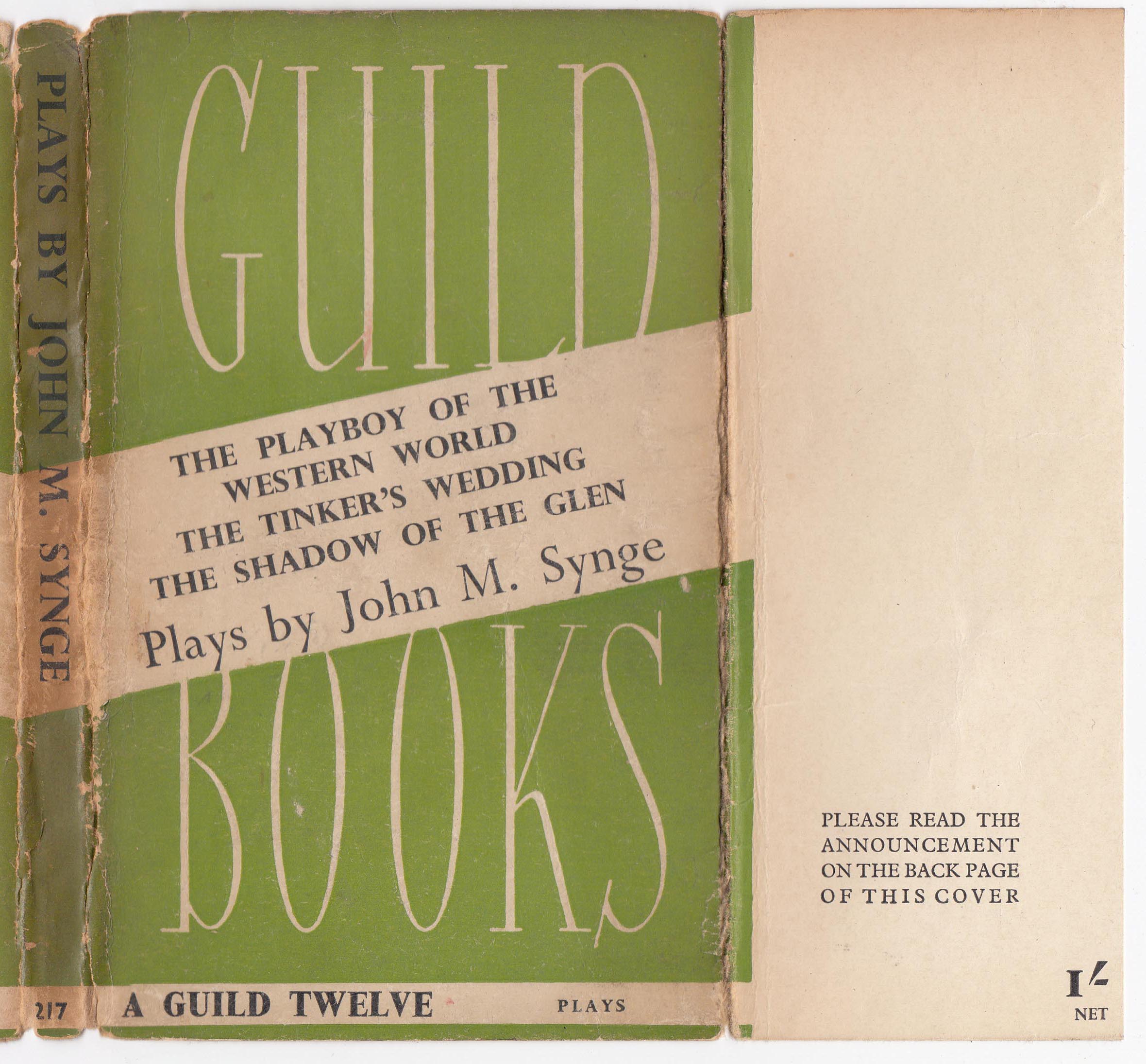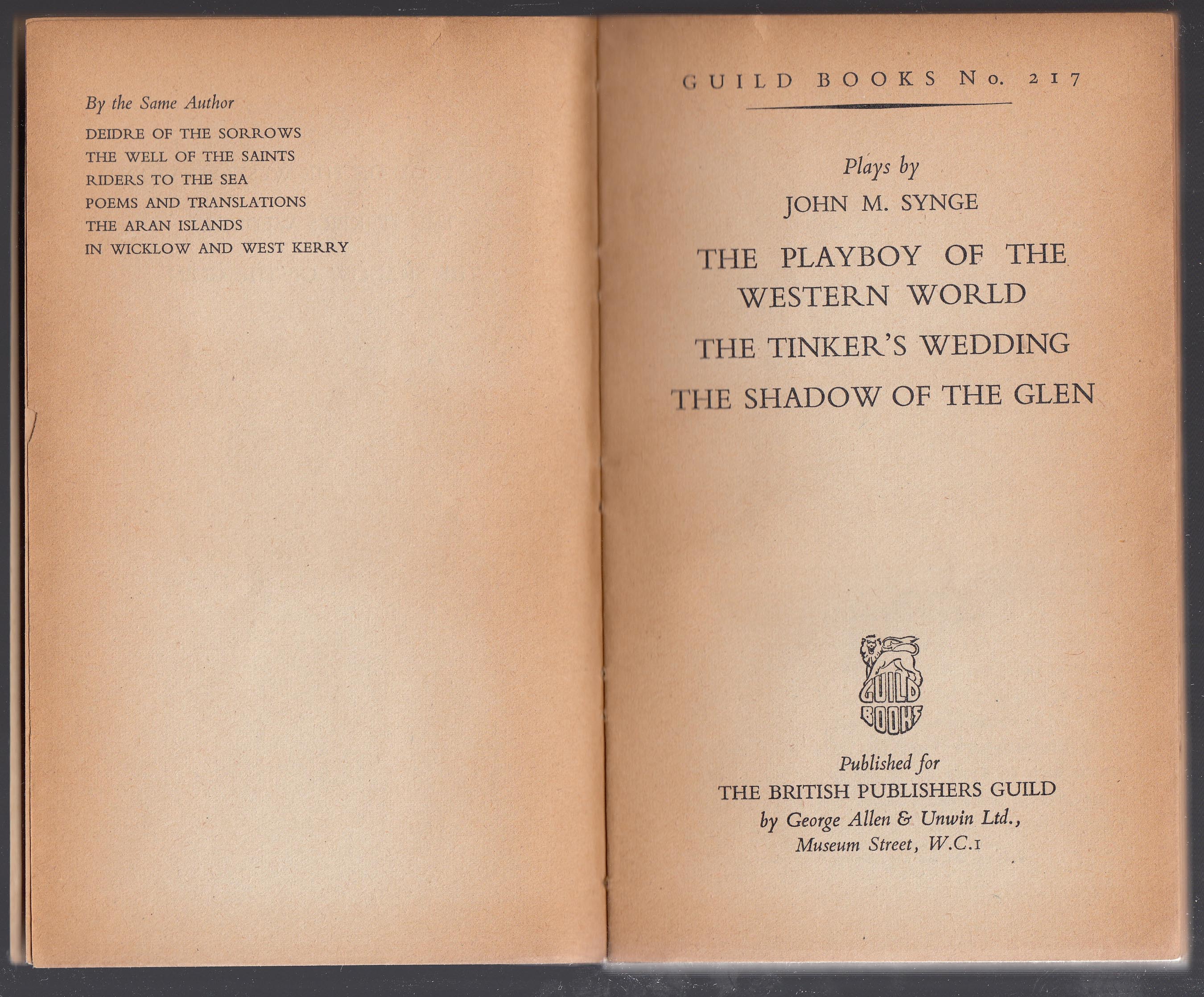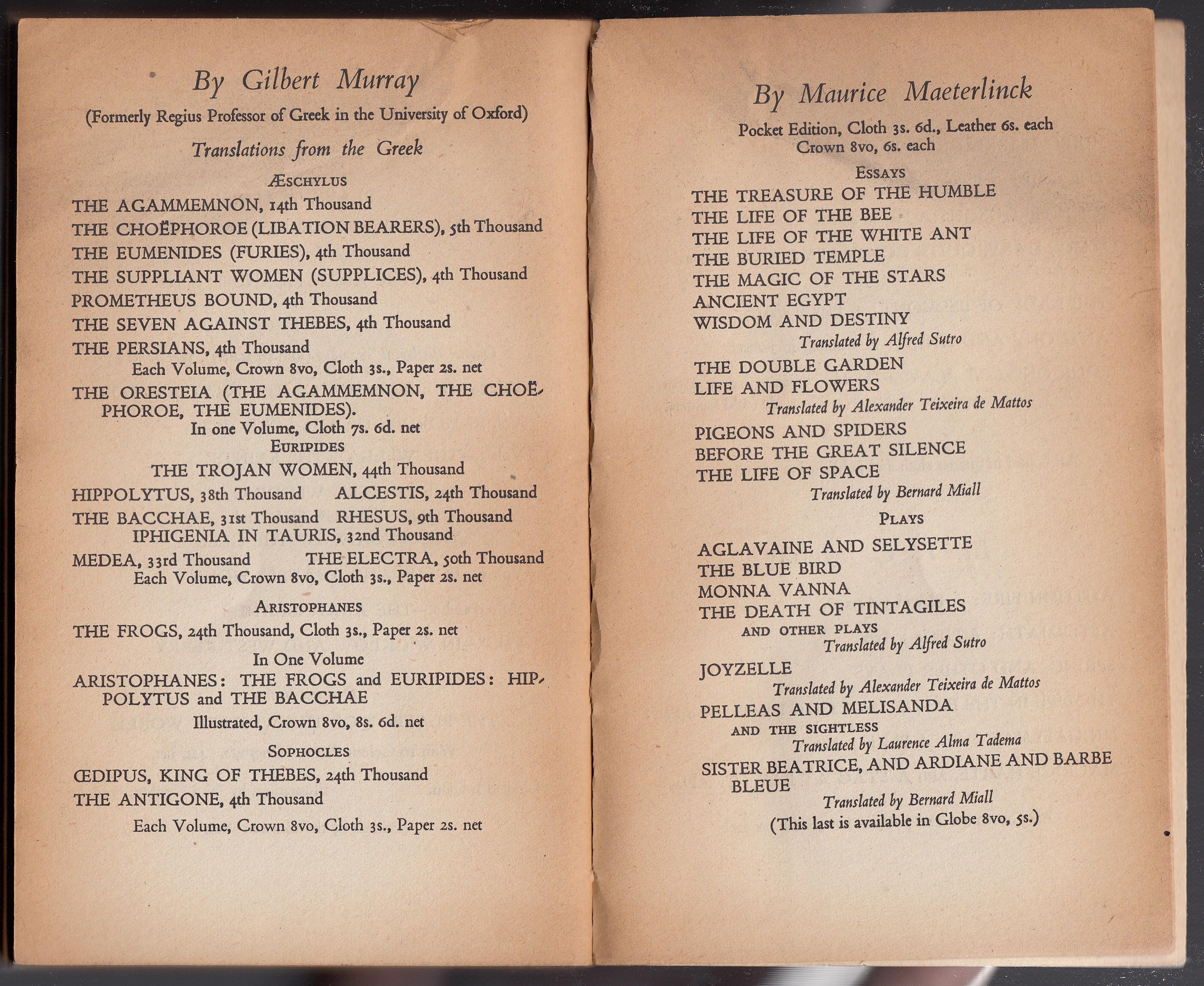British Publishers Guild (London, UK)
Series dates: 1941-1955
Size: 4.25″ x 7.25″
The paperbound Guild Books series (published between 1941 and 1955) was initially intended to compete with Penguin Books, which dominated the low-end of the book market after their initial release in 1935. Individual publishers issued their own Penguinesque paperback series, but paper shortages (due to the war) and the sheer force of the Penguin juggernaut led to a different strategy: collective publishing. The British Publishers Guild, initially led by George Harrap, consisted of publishers banding together to issue a Penguin competitor, first announced in August of 1940. This tactic was similar to Blue Ribbon Books in the US, established in 1930, a coalition of publishers working together to compete with powerhouse (hardcover) reprint house Grosset & Dunlap.
Each of the 8 original publishers involved (Jonathan Cape, Cassell, Chatto & Windus, Dent, Faber & Faber, Harrap, Heinemann, and Murray) were to publish their own contributions to the series, but in a common format. The imprint on the books was, typically, “Published for The British Publishers Guild by …” with the member firm indicated. All titles were to be copyright titles, thus none of the typical classics were included in the series. The first titles were issued in February of 1941. The series was never particularly successful, at least in its original goal to challenge Penguin. Coordinating the collective publishing effort was difficult, and titles were slower to be issued than originally anticipated.
According to Paperback Revolution, the original issue consisted of “36 books, split equally between the Guild Six, Guild Nine and Guild Twelve. The numbers referred to the price – sixpence each for the Guild Six books – colour-coded red, ninepence for the blue Guild Nines and one shilling for the green Guild Twelves. Penguins at the time were still sixpence, so they were matching them only at the bottom end of their pricing, reserved for the shortest and slimmest books, while longer books were up to twice as expensive.”
Early Guild Books titles were jacketed, like early Penguin titles as well as many other 1930s-1940s paperback series. The extra expense of a jacket is somewhat curious, given that the point of these paperbound reprints was to cut costs and lower prices on books. However, it seems that dust jackets (as well as the size of the books, which was similar to many smaller hardbound reprint series) served as an assurance to buyers that these were legitimate books, via the form (size, jackets) – despite being paperbound. The jackets may also have been comforting to the publishers, who seem, by and large, to be a conservative bunch. Subsequently, the jackets disappeared and the size of the books shrunk to the common pocket-sized, no-jacketed paperback that dominated from the 1940s onward.
The tripartite series (Six, Nine, Twelve) eventually generated 18 Guild Six titles numbered #1-#18, 20 Guild Nine titles, numbered #101-#120, and 21 or 22 Guild Twelve titles, numbered #201-221 (and possibly #222). I have not found a specific title assigned to #222. Thus 59 or 60 titles issued in the initial Guild Books series. Those titles are listed by subseries at the end of this entry.
In 1946, Lark Rise by Flora Thompson was published (by the Guild and Oxford University Press) as #223 in the Guild Books, redesigned with the three price-point divisions gone. The last title in the Guide Books series is #478, issued in 1955 (by the Guild and Allen & Unwin): Albert Schweitzer, My Life and Thought. If all the titles in this second iteration of the Guild Books (#223 to #478) were published, that includes 255 more titles. Thus the Guild Books series had a total of 314 or 315 titles.
The British Publishers Guild also issued other Guild Books subseries.
The Guild Books Services Editions were issued between 1943 and 1946, reaching 231 titles according to Paperback Revolution. A tentative checklist is here. A “S” was appended to the series number for these titles. Such “services editions” or “service libraries” were issued for the troops by many different publishers in paperback and hardcover (Chatto & Windus’ Services Library, Harrap’s Services Edition) during WW2.
The Guild Books Continental Editions were an attempt by the British Publishers Guild to sell books on the continent. Tiles were issued in English (1944-1945), German (as Guild Books Guild German) from 1945-1948, and Austrian (as Guild Books Guild Austria) from 1945-1948. There were also Guild Books Australian Editions from 1944-1945.
By 1947, 26 publishers were part of the Guild: Allen & Unwin, Edward Arnold, Cambridge University Press, Chapman & Hall, Constable, Cresset Press, Peter Davies, Eyre & Spottiswoode, Robert Hale, Hamish Hamilton, Michael Joseph, John Lane, The Bodley Head, Longman, Green, Lutterworth Press, Methuen. Frederick Muller, Oxford University Press, and Secker & Warburg.
A late entry (ca. 1953-1954) in the Guild Books array of subseries were the Guild Originals. This consisted of at least 9 titles that were apparently paperback titles published by Guild Books simultaneously with the original hardcover issue. The Brass Penguin site lists three of the 9 titles here.
Sources: Paperback Revolution blog and Herbert Simon, “The British Publishers Guild,” British Book News, 1947, p. 28-31.
Plays by John M. Synge (The Playboy of the Western World, The Tinker’s Wedding, The Shadow of the Glen) is among the titles published in the Guild Book’s first year. Jackets are common to the series, with a simple geometric design revealing the influence of the design of Penguin Books. The series name fills the background with a band (with a white background) left for printing the title and author. The color corresponds to the price category: green, in this case, for “Guild Twelve”). That price category is also indicated in a band along the bottom of the jacket front, where the book is also placed in the category of “Plays.” The jacket spine includes the book title and series number (in this case, #217). The front jacket flap directs the reader to “Please Read The Announcement on the Back Page of this Cover” and indicates the price (1s, net).
The back of the book lays out the goals and intent of the British Publishers Guild and the Guild Book series:
“The British Publishers Guild is composed of a large group of British Publishers co-operating with the object of issuing and maintaining a comprehensive list of good books in cheap editions.”
“In presenting Guild Books, the Guild is fully conscious of the high standard of reading demanded by the public at home and overseas and is confident that the vast resources of its members are a guarantee that an ever-changing list of first-class books will be constantly available.”
“Each book will be produced by the publisher who was responsible for its original publication, but no volume will be issued under the Guild imprint unless unanimously approved by a small selection committee appointed for the purpose.”
“Although many famous books by established authors will be included, the Guild will not hesitate to select any book of quality which will have a wide appeal to readers of to-day.”
Recent publications are then listed, including two Guild Six, three Guild Nine, and two Guild Twelve titles.
“Classification of Titles: (F) Fiction, (S) Science, (AB) Autobiography, (P) Plays”
The rear jacket flap advertises the London Calling Overseas radio show.
The book’s paper cover repeats the content of the jacket, minus the information on the jacket flaps.
The half-title page:
A list of titles “By the Same Author” faces the title page. The title page is headed by the series name and this title’s series number (#217), followed by the title, list of the plays in the book, and publisher’s imprint. The particular publisher of this title is George Allen & Unwin.
“First published in this series in 1941.”
“Made and Printed in Great Britain by Morrison and Gibb Ltd., London and Edinburgh.”
Given that titles in the Guild Books were printed by the Guild member firm who originally published the book, the publisher had the option to add their own advertising to a title. In this case, “Particulars of publications of similar interest issued by” followed by a George Allen & Unwin colophon. A catalog of titles by J.M. Synge, Gilbert Murray, Maurice Maeterlinck, St. John G. Ervine and T.C. Murray follow.
Guild Book titles: Guild Six, Guild Nine, and Guild Twelve: 1941-1946
Modified from list at Brass Penguin site. While a nice start, the original list had numerous typos. I also added full author names as well as the Guild member publisher and initial year of publication.
Guild Six
1. James M. Cane, The Postman Always Rings Twice (Cape, 1941)
2. Winston S. Churchill, Blenheim, from Marlborough, vol. II (Harrap, 1941)
3. David Garnett, The Sailor’s Return (Chatto & Windus, 1941)
4. William Fryer Harvey, The Beast With Five Fingers (Dent, 1941)
5. I.A.R. Wylie, The Young In Heart (Cassell, 1941)
6. F.B. Young, Portrait Of A Village (Heinemann, 1941)
7. Radja Aundh, The Ten Point Way To Health (Dent, 1941)
8. Enid Bagnold, The Squire (Heinemann, 1941)
9. Edgar Christian, Unflinching (John Murray, 1941)
10. W. Corcoran, This Man Murray (Dent, 1941)
11. F.H. Grisewood, Our Bill (Harrap, 1941)
12. André Maurois, The Thought-Reading Machine (Cape, 1941)
13. Douglas Brown & Christopher Serpell, If Hitler Comes (Faber & Faber, 1941)
14. Leland Shattuck Jamieson, Attack! (Harrap, 1942)
15. Maurice Maeterlinck, The Life of the Ant (George Allen, 1941)
16. H.E. Bates (as ‘Flying Officer X’), The Greatest People In The World (Cape, 1942)
17. H.E. Bates (as ‘Flying Officer X’), How Sleep The Brave (Cape, 1943)
18. Eugène Brieux, Damaged Goods (Cape, 1943)
Guild Nine
101. Jane Allen, I Lost My Girlish Laughter (Faber & Faber, 1941)
102. Martin Boyd, The Lemon Farm (Dent, 1941)
103. J.B. Priestley, Benighted (Heinemann, 1941)
104. Richard Sale, Not Too Narrow…Not Too Deep (Cassell, 1941)
105. Dorothy Whipple, High Wages (John Murray, 1941)
106. Robert A Winston, Dive Bomber (Harrap, 1941)
107. Adrian Alington, Donaldson (Chatto & Windus, 1941)
108. John Brophy, Waterfront (Cape, 1941)
109. J. Harpole, Leaves From A Surgeon’s Case-book (Cassell, 1941)
110. Graham Greene, Stamboul Train (Heinemann, 1941)
111. P.C Wren, Fort In The Jungle (John Murray, 1943)
112. John Dickson Carr, Death in Five Boxes (Heinemann, 1941)
113. Frederick Treves, The Elephant Man and Other Reminiscences (Cassell, 1941)
114. Horace Annesley Vachell, Her Son (Murray, 1942)
115. David Garnett, Beany-Eye (Chatto & Windus, 1941)
116. John Steinbeck, The Moon Is Down (Heninemann, 1942)
117. Our Penelope, by Her Company (Harrap, 1943)
118. Kenneth Bradley, Diary of a District Officer (Harrap, 1943)
119. William Dwight Whitney, Who Are The Americans? (Eyre and Spottiswood, 1943)
120. Wallace Reyburn, Rehearsal For Invasion (Harrap, 1943)
Guild Twelve
201. Gerald Bullet, The Jury (Dent, 1941)
202. L. Bromfield, McLeod’s Folly (Cassell, 1941)
203. Ernest Hemingway, Fiesta (American title: The Sun Also Rises) (Cape, 1941)
204. W. Somerset Maugham, Theatre (Heinemann, 1941)
205. Knud Holmboe, Desert Encounter (Harrap, 1941)
206. A.G. Street, Strawberry Roan (Faber & Faber, 1941)
207. Sheila Kaye Smith, The Village Doctor (Cassell, 1941)
208. A.E.W. Mason, The Truants (Murray or Hodder and Stoughton, 194?)
209. William Buehler, Adventures In Arabia (Harrap, 1941)
210. Walter Starkie, Raggle-Taggle (John Murray, 1941)
211. Thomas Woodrooffe, River Of Golden Sand (Faber & Faber, 1941)
212. Beverly Nichols, A Thatched Roof (Cape, 1941)
213. Richard Albert Wilson, Miraculous Birth Of Language (Dent, 1941)
214. Walter Greenwood, Love On The Dole (Cape, 1942)
215. Herbert Agar, A Time For Greatness (Eyre & Spottiswoode, 1943)
216. C.J. Rolo, Wingate’s Raiders (Harrap, 1945)
217. J.M. Synge, Plays: The Playboy of the Western World, The Tinker’s Wedding, The Shadow of the Glen (Allen & Unwin, 1941)
218. J.M. Synge, Plays: Riders to the Sea, Deirdre of the Sorrows, The Well of the Saints (Allen & Unwin, 1941)
219. Willard Price, Japan’s Islands Of Mystery (Heinemann, 1945)
220. Roger Fulford, Right Honorable Gentleman (John Murray, 1946)
221. Robert L. Duffus, Tomorrow Never Comes (Harrap, 1946)
222. ?
General Guild Books series
See the list at Brass Penguin.








